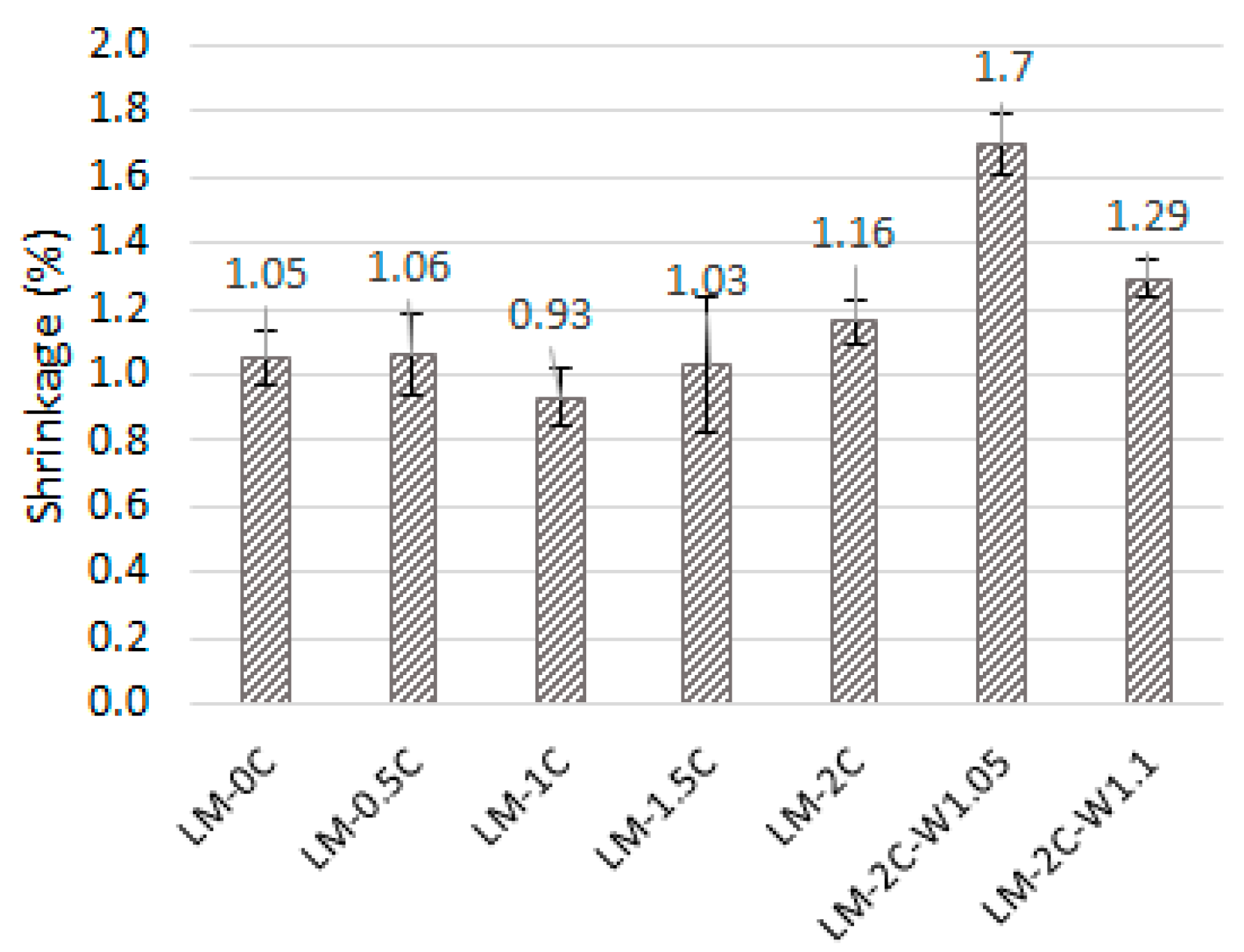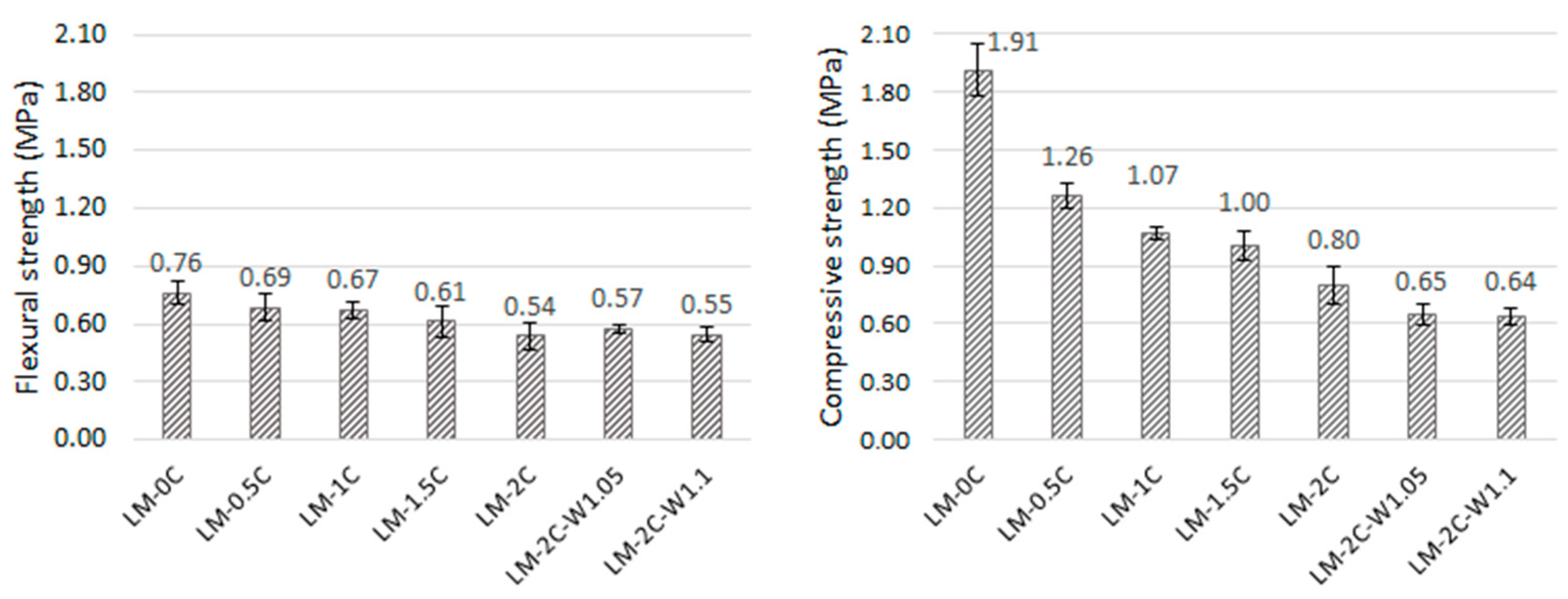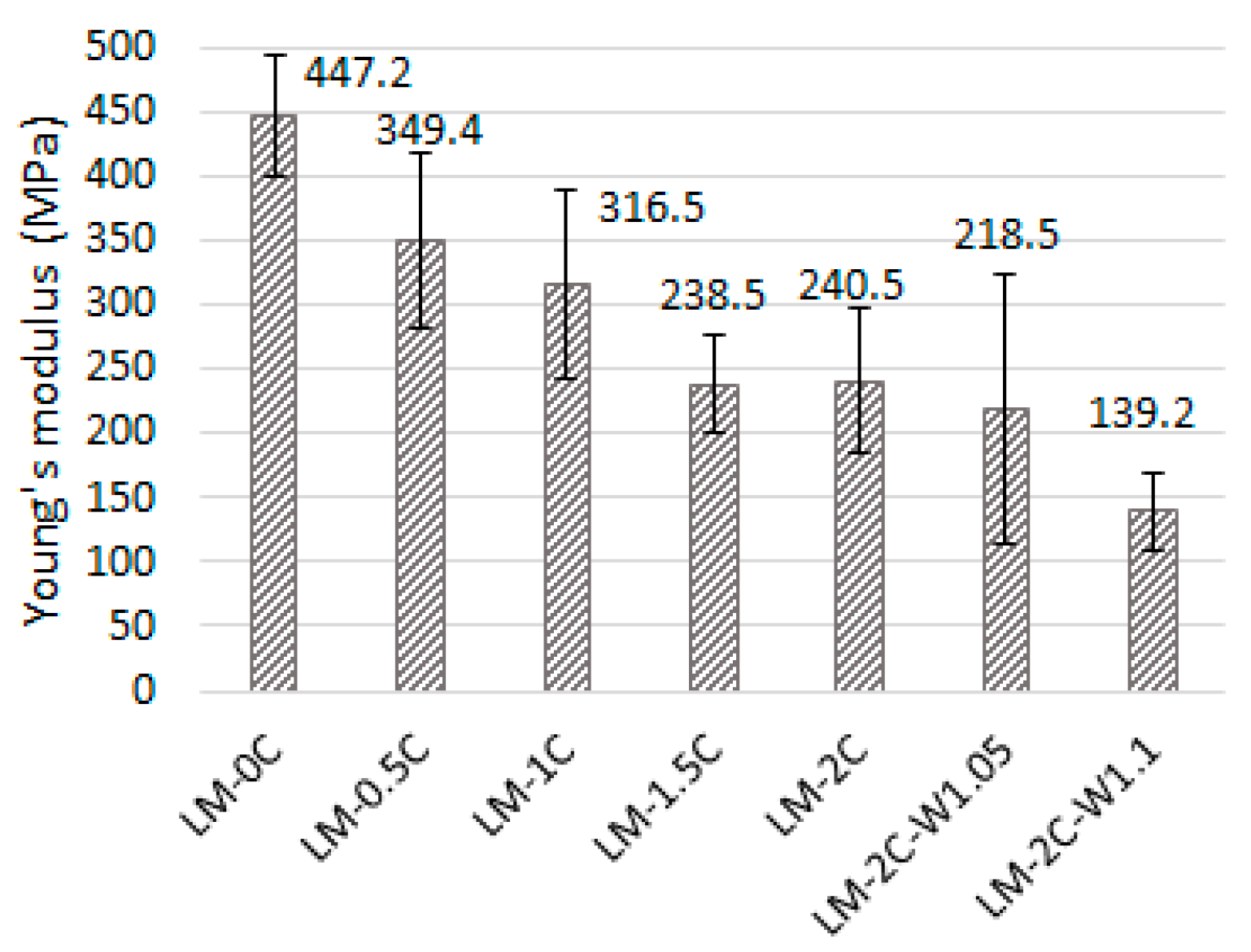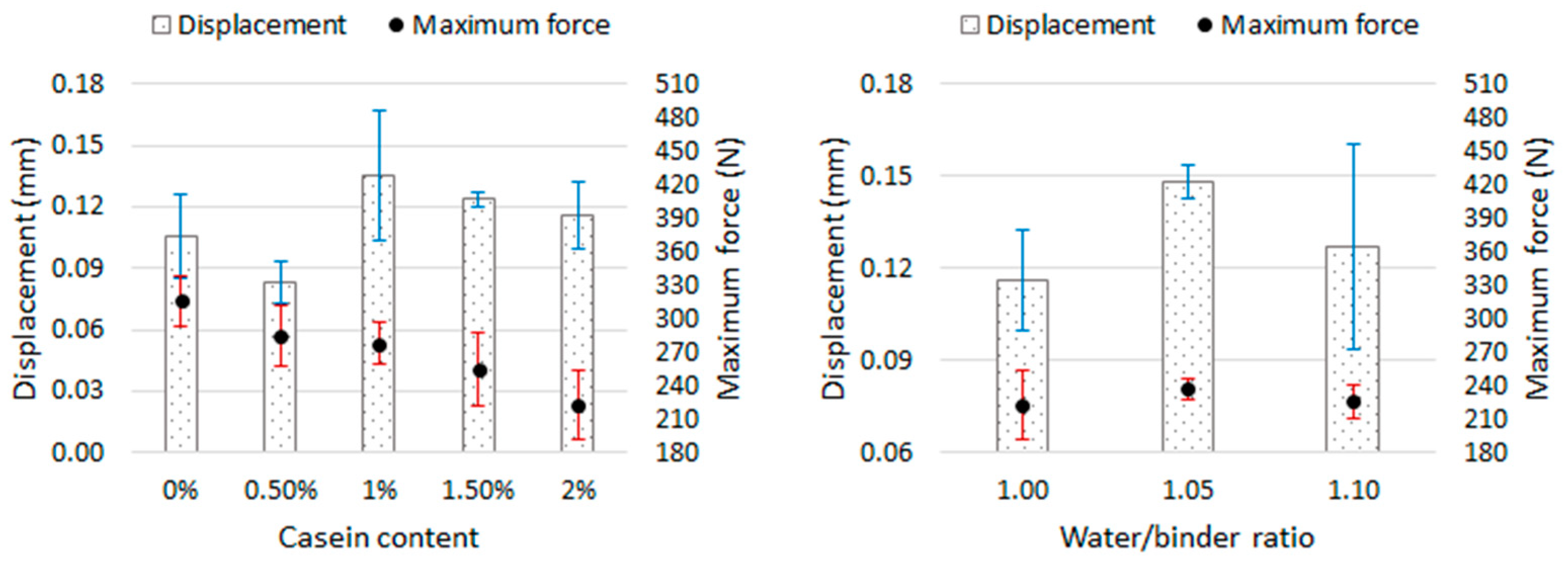The Influence of Acid Casein on the Selected Properties of Lime–Metakaolin Mortars
Abstract
:1. Introduction
2. Materials and Methods
2.1. Mix Design
2.2. Preparation of Specimens
2.3. Mortar Testing
3. Results
3.1. Consistency
3.2. Apparent Density, Specific Density, and Total Porosity
3.3. Shrinkage
3.4. Mass Absorptivity
3.5. Capillary Rise
3.6. Flexural and Compressive Strengths and Young’s Modulus
4. Discussion
4.1. Consistency
4.2. Apparent Density, Specific Density, and Total Porosity
4.3. Shrinkage
4.4. Mass Absorptivity
4.5. Capillary Rise
4.6. Flexural and Compressive Strength and Young’s Modulus
5. Conclusions
- The consistency of mortar mixtures thickens as the casein content increases. Increasing the amount of water in the mortar with 2% casein plasticizes the consistency, but it is still thicker than in the case of the reference mortar.
- The porosity of mortars increased with an increase in the content of a casein admixture. A more dynamic increase in porosity occurred with an increase in the water content.
- There was no dependence of shrinkage on the amount of casein added. The most noticeable increase in shrinkage occurred in a mortar with an admixture of 2%. Increasing the amount of water increased the shrinkage value (by 46% and 11%).
- Selected amounts of casein added (0.5%, 1%, 2%) slightly reduced water absorption. Water absorption increased (by 3.9% and 4.7%) when the water-to-binder ratio increased.
- The addition of casein reduced the capillary rise of water. Only an admixture of 0.5% increased the water absorption capacity.
- As the casein content increased, the flexural strength (by 9–29%) and the compressive strength decreased (by 34–58%). Increasing the w/s ratio did not cause significant changes compared to w/b = 1 in the case of bending strength but reduced compressive strength by 19–20%.
- As the casein content increased, the value of the elastic modulus decreased. Increasing the w/s ratio also resulted in a decrease in the value of Young’s modulus.
Author Contributions
Funding
Institutional Review Board Statement
Informed Consent Statement
Data Availability Statement
Acknowledgments
Conflicts of Interest
References
- Veiga, R. Air lime mortars: What else do we need to know to apply them in conservation and rehabilitation interventions? A review. Constr. Build. Mater. 2017, 157, 132–140. [Google Scholar] [CrossRef]
- Velosa, A.; Coroado, J.; Veiga, M.; Rocha, F. Characterisation of roman mortars from Conímbriga with respect to their repair. Mater. Charact. 2007, 58, 1208–1216. [Google Scholar] [CrossRef]
- Silva, D.; Wenk, H.; Monteiro, P. Comparative investigation of mortars from Roman Colosseum and cistern. Thermochim. Acta 2005, 438, 35–40. [Google Scholar] [CrossRef]
- Brzyski, P. The Influence of Gum Arabic Admixture on the Mechanical Properties of Lime-Metakaolin Paste Used as Binder in Hemp Concrete. Materials 2021, 14, 6775. [Google Scholar] [CrossRef] [PubMed]
- Grudzińska, M.; Brzyski, P. The Occurrence of Thermal Bridges in Hemp-Lime Construction Junctions. Period. Polytech. Civ. Eng. 2019, 63, 377–387. [Google Scholar] [CrossRef]
- Malathy, R.; Shanmugam, R.; Chung, I.-M.; Kim, S.-H.; Prabakaran, M. Mechanical and Microstructural Properties of Composite Mortars with Lime, Silica Fume and Rice Husk Ash. Processes 2022, 10, 1424. [Google Scholar] [CrossRef]
- Pozo-Antonio, J. Evolution of mechanical properties and drying shrinkage in lime-based and lime cement-based mortars with pure limestone aggregate. Constr. Build. Mater. 2015, 77, 472–478. [Google Scholar] [CrossRef]
- Nayak, J.R.; Bochen, J.; Gołaszewska, M. Experimental studies on the effect of natural and synthetic fibers on properties of fresh and hardened mortar. Constr. Build. Mater. 2022, 347, 128550. [Google Scholar] [CrossRef]
- Silva, B.; Pinto, A.F.; Gomes, A.; Candeias, A. Short- and long-term properties of lime mortars with water-reducers and a viscosity-modifier. J. Build. Eng. 2021, 43, 103086. [Google Scholar] [CrossRef]
- Marques, A.I.; Morais, J.; Morais, P.; Veiga, M.D.R.; Santos, C.; Candeias, P.; Ferreira, J.G. Modulus of elasticity of mortars: Static and dynamic analyses. Constr. Build. Mater. 2020, 232, 117216. [Google Scholar] [CrossRef]
- Silva, B.; Pinto, A.F.; Gomes, A.; Candeias, A. Effects of natural and accelerated carbonation on the properties of lime-based materials. J. CO2 Util. 2021, 49, 101552. [Google Scholar] [CrossRef]
- Athira, V.S.; Manohar, S. Carbonation of Air Lime Mortars under Natural and Accelerated Conditions—A Systematic Review. Mater Today Proc. 2023. [Google Scholar] [CrossRef]
- Brzyski, P. The effect of pozzolan addition on the physical and mechanical properties of lime mortar. E3S Web Conf. 2018, 49, 9. [Google Scholar] [CrossRef]
- Gameiro, A.; Silva, A.S.; Faria, P.; Grilo, J.; Branco, T.; Veiga, R.; Velosa, A. Physical and chemical assessment of lime–metakaolin mortars: Influence of binder:aggregate ratio. Cem. Concr. Compos. 2014, 45, 264–271. [Google Scholar] [CrossRef]
- Kang, S.-H.; Kwon, Y.-H.; Moon, J. Quantitative Analysis of CO2 Uptake and Mechanical Properties of Air Lime-Based Materials. Energies 2019, 12, 2903. [Google Scholar] [CrossRef]
- Aggelakopoulou, E.; Bakolas, A.; Moropoulou, A. Properties of lime–metakolin mortars for the restoration of historic masonries. Appl. Clay Sci. 2011, 53, 15–19. [Google Scholar] [CrossRef]
- Padovnik, A.; Bokan-Bosiljkov, V. The Influence of Dry Hydrated Limes on the Fresh and Hardened Properties of Architectural Injection Grout. Materials 2021, 14, 5585. [Google Scholar] [CrossRef] [PubMed]
- Romagnoli, M.; Gualtieri, M.L.; Hanuskova, M.; Rattazzi, A.; Polidoro, C. Effect of drying method on the specific surface area of hydrated lime: A statistical approach. Powder Technol. 2013, 246, 504–510. [Google Scholar] [CrossRef]
- Maria, S. Methods for porosity measurement in lime-based mortars. Constr. Build. Mater. 2010, 24, 2572–2578. [Google Scholar] [CrossRef]
- Arandigoyen, M.; Alvarez, J. Pore structure and mechanical properties of cement–lime mortars. Cem. Concr. Res. 2007, 37, 767–775. [Google Scholar] [CrossRef]
- Papayianni, I.; Stefanidou, M. Strength–porosity relationships in lime–pozzolan mortars. Constr. Build. Mater. 2006, 20, 700–705. [Google Scholar] [CrossRef]
- Gulbe, L.; Vitina, I.; Setina, J. The Influence of Cement on Properties of Lime Mortars. Procedia Eng. 2017, 172, 325–332. [Google Scholar] [CrossRef]
- Brzyski, P.; Grudzińska, M. Influence of Linseed Oil Varnish Admixture on Glauconite Clay Mortar Properties. Materials 2020, 13, 5487. [Google Scholar] [CrossRef] [PubMed]
- Elert, K.; Sánchez, R.M.G.; Benavides-Reyes, C.; Ordóñez, F.L. Influence of animal glue on mineralogy, strength and weathering resistance of lime plasters. Constr. Build. Mater. 2019, 226, 625–635. [Google Scholar] [CrossRef]
- Ventolà, L.; Vendrell, M.; Giraldez, P.; Merino, L. Traditional organic additives improve lime mortars: New old materials for restoration and building natural stone fabrics. Constr. Build. Mater. 2011, 25, 3313–3318. [Google Scholar] [CrossRef]
- Jasiczak, J.; Zielinski, K. Effect of protein additive on properties of mortar. Cem. Concr. Compos. 2006, 28, 451–457. [Google Scholar] [CrossRef]
- Mydin, M.A.O. Physico-Mechanical Properties of Lime Mortar by Adding Exerted Egg Albumen for Plastering Work in Conservation Work. J. Mater. Environ. Sci. 2018, 2508, 2. [Google Scholar]
- Mydin, A.O. Preliminary Studies on the Development of Lime-based Mortar with Added Egg White. Int. J. Technol. 2017, 8, 800. [Google Scholar] [CrossRef]
- Guo, M.; Wang, G. Milk Protein Polymer and Its Application in Environmentally Safe Adhesives. Polymers 2016, 8, 324. [Google Scholar] [CrossRef]
- Desport, J.S.; Picchio, M.L.; Gugliotta, L.M.; Barandiaran, M.J.; Minari, R.J. Waterborne Coatings from Casein and Carbohydrate Biobased Raw Materials. In Handbook of Waterborne Coatings; Elsevier: Amsterdam, The Netherlands, 2020. [Google Scholar] [CrossRef]
- Plank, J.; Bian, H. Method to assess the quality of casein used as superplasticizer in self-levelling compounds. Cem. Concr. Res. 2010, 40, 710–715. [Google Scholar] [CrossRef]
- Brzyski, P.; Suchorab, Z.; Łagód, G. The Influence of Casein Protein Admixture on Pore Size Distribution and Mechanical Properties of Lime-Metakaolin Paste. Buildings 2021, 11, 530. [Google Scholar] [CrossRef]
- Park, S.-S.; Woo, S.-W.; Jeong, S.-W.; Lee, D.-E. Durability and Strength Characteristics of Casein-Cemented Sand with Slag. Materials 2020, 13, 3182. [Google Scholar] [CrossRef] [PubMed]
- Brzyski, P.; Suchorab, Z. Physical Properties of Clay Mortars Based on Insulating Aggregates. AIP Conf. Proc. 2018, 1988. [Google Scholar] [CrossRef]
- PN-EN 1015-3; Methods of Test for Mortar for Masonry—Part 3: Determination of Consistence of Fresh Mortar (by Flow Table). Polish Committee for Standardization: Warsaw, Poland, 2000.
- PN-EN 1015-4; Methods of Test for Mortar for Masonry—Part 4: Determination of Consistence Of fresh Mortar (by Plunger Penetration). Polish Committee for Standardization: Warsaw, Poland, 2000.
- PN-EN 1015-6; Methods of Test for Mortar for Mason–y—Part 6: Determination of Bulk Density of Fresh Mortar. Polish Committee for Standardization: Warsaw, Poland, 2000.
- PN-EN 1936; Natural Stone Test Methods-Determination of Real Density and Apparent Density, and of Total and Open Porosity. Polish Committee for Standardization: Warsaw, Poland, 2010.
- PN-EN 13755; Natural Stone Test Metho–s-Determination of Water Absorption at Atmospheric Pressure. Polish Committee for Standardization: Warsaw, Poland, 2002.
- PN-EN 1015-18; Methods of Test for Mortar for Masonry—Part 18: Determination of Water Absorption Coefficient Due to Capillary Action of Hardened Mortar. Polish Committee for Standardization: Warsaw, Poland, 2003.
- PN-EN 1015-11; Methods of test for Mortar for Masonry—Part 11: Determination of Flexural and Compressive Strength of Hardened Mortar. Polish Committee for Standardization: Warsaw, Poland, 2001.
- Davarpanah, S.M.; Ván, P.; Vásárhelyi, B. Investigation of the relationship between dynamic and static deformation moduli of rocks. Géoméch. Geophys. Geo-Energy Geo-Resour. 2020, 6, 29. [Google Scholar] [CrossRef]
- Rosell, J.R.; Cantalapiedra, I.R. Simple Method of Dynamic Young’s Modulus Determination in Lime and Cement Mortars. Mater. De Construcción 2011, 61, 301. [Google Scholar]
- Walker, R.; Pavia, S.; Mitchell, R. Mechanical properties and durability of hemp-lime concretes. Constr. Build. Mater. 2014, 61, 340–348. [Google Scholar] [CrossRef]
- Costigan, A.; Pavía, S.; Kinnane, O. An experimental evaluation of prediction models for the mechanical behavior of unreinforced, lime-mortar masonry under compression. J. Build. Eng. 2015, 4, 283–294. [Google Scholar] [CrossRef]
- Zheng, S.; Liu, T.; Jiang, G.; Fang, C.; Qu, B.; Gao, P.; Li, L.; Feng, Y. Effects of Water-to-Cement Ratio on Pore Structure Evolution and Strength Development of Cement Slurry Based on HYMOSTRUC3D and Micro-CT. Appl. Sci. 2021, 11, 3063. [Google Scholar] [CrossRef]
- Alsayed, S.H.; Amjad, M.A. Strength, Water Absorption and Porosity of Concrete Incorporating Natural and Crushed Aggregate. J. King Saud Univ. Eng. Sci. 1996, 8, 109–119. [Google Scholar] [CrossRef]
- Anna, A.; Giuseppe, C. The water transfer properties and drying shrinkage of aerial lime-based mortars: An assessment of their quality as repair rendering materials. Environ. Earth Sci. 2014, 71, 1699–1710. [Google Scholar] [CrossRef]
- Branco, F.G.; Belgas, M.d.L.; Mendes, C.; Pereira, L.; Ortega, J.M. Characterization of Fresh and Durability Properties of Different Lime Mortars for Being Used as Masonry Coatings in the Restoration of Ancient Constructions. Sustainability 2021, 13, 4909. [Google Scholar] [CrossRef]
- Kim, Y.-Y.; Lee, K.-M.; Bang, J.-W.; Kwon, S.-J. Effect of W/C Ratio on Durability and Porosity in Cement Mortar with Constant Cement Amount. Adv. Mater. Sci. Eng. 2014, 2014, 273460. [Google Scholar] [CrossRef]
- Haach, V.G.; Vasconcelos, G.; Lourenço, P.B. Influence of aggregates grading and water/cement ratio in workability and hardened properties of mortars. Constr. Build. Mater. 2011, 25, 2980–2987. [Google Scholar] [CrossRef]
- Singh, S.; Munjal, P.; Thammishetti, N. Role of water/cement ratio on strength development of cement mortar. J. Build. Eng. 2015, 4, 94–100. [Google Scholar] [CrossRef]












| Recipe Symbol | Components | |||
|---|---|---|---|---|
| Binder | Casein:Binder | (Binder + Casein):Sand | Water/(Binder + Casein) | |
| LM-0C | Hydrated lime 90% Metakaolin 10% | 0:1 | 1:5 | 1.00 |
| LM-0.5C | 0.05:0.995 | |||
| LM-1C | 0.01:0.99 | |||
| LM-1.5C | 0.015:0.985 | |||
| LM-2C | 0.02:0.98 | |||
| LM-2C-W1.05 | 0.02:0.98 | 1.05 | ||
| LM-2C-W1.1 | 0.02:0.98 | 1.10 | ||
| Parameter | LM-0C | LM-0.5C | LM-1C | LM-1.5C | LM-2C | LM-2C-W1.05 | LM-2C-W1.1 |
|---|---|---|---|---|---|---|---|
| Apparent density (kg/m3) | 1854 | 1840 | 1856 | 1837 | 1822 | 1804 | 1791 |
| Specific density (kg/m3) | 2616 | 2619 | 2619 | 2634 | 2623 | 2624 | 2661 |
| Total porosity (%) | 29.1 | 29.8 | 29.1 | 30.3 | 30.5 | 31.3 | 32.7 |
Disclaimer/Publisher’s Note: The statements, opinions and data contained in all publications are solely those of the individual author(s) and contributor(s) and not of MDPI and/or the editor(s). MDPI and/or the editor(s) disclaim responsibility for any injury to people or property resulting from any ideas, methods, instructions or products referred to in the content. |
© 2023 by the authors. Licensee MDPI, Basel, Switzerland. This article is an open access article distributed under the terms and conditions of the Creative Commons Attribution (CC BY) license (https://creativecommons.org/licenses/by/4.0/).
Share and Cite
Brzyski, P.; Boris, R. The Influence of Acid Casein on the Selected Properties of Lime–Metakaolin Mortars. Materials 2023, 16, 7050. https://doi.org/10.3390/ma16217050
Brzyski P, Boris R. The Influence of Acid Casein on the Selected Properties of Lime–Metakaolin Mortars. Materials. 2023; 16(21):7050. https://doi.org/10.3390/ma16217050
Chicago/Turabian StyleBrzyski, Przemysław, and Renata Boris. 2023. "The Influence of Acid Casein on the Selected Properties of Lime–Metakaolin Mortars" Materials 16, no. 21: 7050. https://doi.org/10.3390/ma16217050






